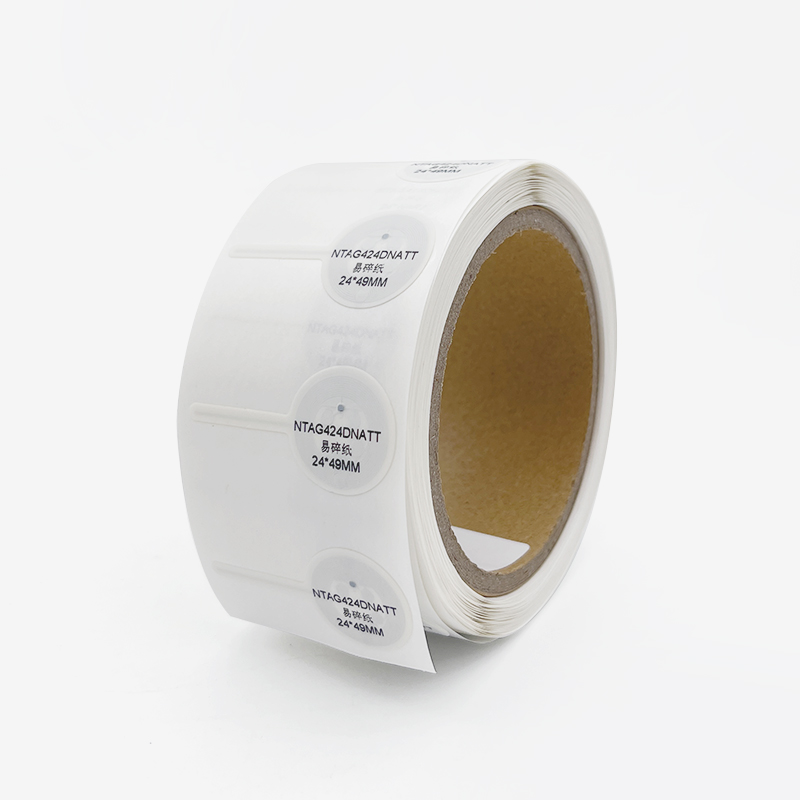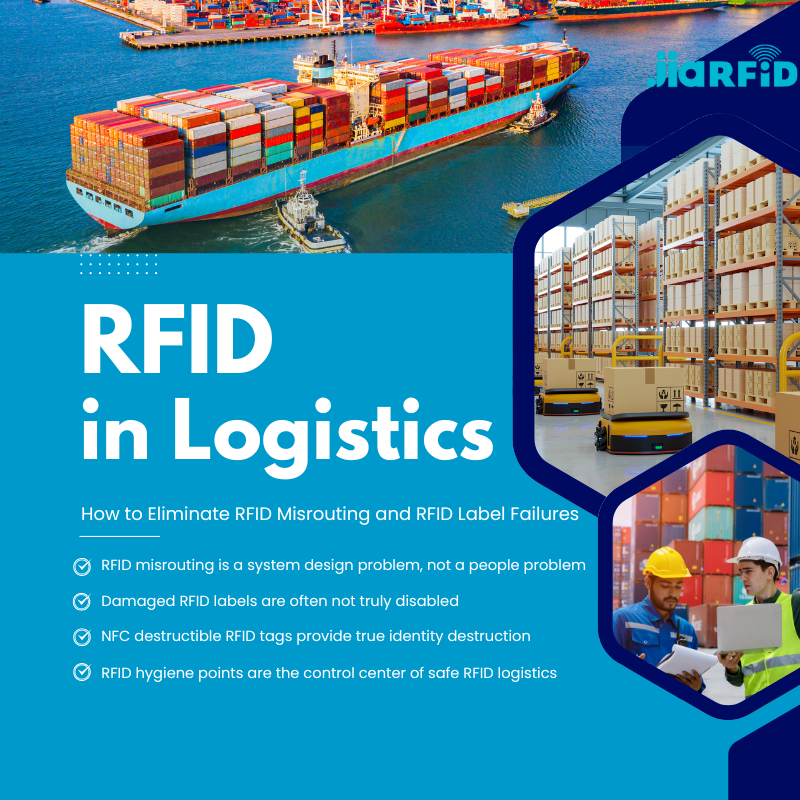
RF ve RFID Etiketleri Arasındaki Fark Nedir?
İçindekiler
RF ve RFID Etiketleri Arasındaki Fark: Tanımlar, Teknoloji ve Depolamada Uygulamalar
Ancak, bu terimler genellikle birbirinin yerine kullanılır ve bu da gerçek anlamları ve aralarındaki farklar konusunda kafa karışıklığına yol açar. RF ve RFID arasındaki farkı anlamak, işletmelerin operasyonlarını optimize etmelerine, verimliliği artırmalarına ve daha akıllı teknoloji yatırımları yapmalarına yardımcı olur.
Bu kılavuz, RF teknolojisinin nasıl çalıştığını ve RFID Etiketleri çalışma, aralarındaki farklar ve RFID teknolojisinin modern tedarik zincirlerini neden dönüştürdüğü.

RF Teknolojisi Nedir ve Nasıl Çalışır?
RF (Radyo Frekansı), verileri kablosuz olarak iletmek için elektromanyetik radyo dalgalarının kullanımını ifade eder. RFID teknolojisi, Wi‑Fi ve Bluetooth dahil olmak üzere birçok kablosuz iletişim sisteminin temelini oluşturur.
RF Teknolojisinin Temel Bileşenleri:
- Verici ve Alıcı: Radyo sinyallerini üretir ve yakalar.
- Frekans Aralığı: Kullanım durumuna bağlı olarak birkaç kilohertz (kHz) ile gigahertz (GHz) arasında çalışır.
- Uygulamalar: İletişim sistemlerinde, garaj kapısı uzaktan kumandalarında, kablosuz mikrofonlarda ve güvenlik sistemlerinde yaygın olarak kullanılır.
Kısacası, RF teknolojisi tanımlama, iletişim ve veri alışverişini mümkün kılan kablosuz omurgayı sağlar ve RFID teknolojisi bunun en özel uygulamalarından biridir.
RFID Nedir ve Nasıl Çalışır?
RFID (Radyo Frekansı Tanımlama), etiketlenmiş nesnelerin kablosuz olarak tanımlanmasını ve izlenmesini sağlamak için RF teknolojisini temel alır.
Bir RFID sistemi şunlardan oluşur:
- RFID Etiketleri
- RFID Okuyucu
- Anten ve Yazılım Sistemi
RFID Teknolojisi Nasıl Çalışır?
- Okuyucu Etkinleştirme: RFID okuyucu anten aracılığıyla bir radyo sinyali gönderir.
- Etiket Yanıtı: RFID Etiketi, bu sinyalden enerjiyi yakalar ve depolanan verileri iletir.
- Veri Yakalama: Okuyucu, etiketin yanıtını alır ve verileri merkezi bir veritabanına veya depo yönetim sistemine (WMS) aktarır.
Barkodların aksine, RFID Etiketleri görüş hattı taraması gerektirmez — bu sayede birden fazla etiket aynı anda okunabilir ve yoğun ortamlarda verimlilik artar.
RF ve RFID Arasındaki Fark
RF, kablosuz iletişimin daha geniş bir kategorisini temsil ederken, RFID, ürün tanımlama ve veri izleme için tasarlanmış RF teknolojisinin özel bir uygulamasıdır.
| Özellik | R.F. | RFID |
|---|---|---|
| Tanım | Kablosuz veri iletimi için radyo dalgalarının genel kullanımı | Nesne tanımlama ve izleme için RF uygulaması |
| Ana Bileşenler | Verici ve alıcı | Etiketler, okuyucular, antenler ve yönetim yazılımı |
| İletişim Türü | Temel sinyal iletimi | İki yönlü kimlik belirleme ve veri alışverişi |
| Uygulamalar | Radyolar, uzaktan kumandalar, Wi‑Fi, güvenlik sistemleri | Depo yönetimi, lojistik, perakende, erişim kontrolü |
| Veri İşlevselliği | Ham sinyal verilerini aktarır | Fiziksel varlıklarla bağlantılı dijital bilgileri depolayan aktarımlar |
RFID Etiketleri Nasıl Çalışır?
RFID etiketleri, verileri depolayan ve bir RFID okuyucuya gönderen minyatür cihazlardır. Her etiket şunları içerir:
- Mikroçip (IC): Benzersiz kimlik verilerini depolar.
- Anten: Enerji alır ve sinyalleri iletir.
- Alt tabaka/Dolgu: İç bileşenleri korur.
Bir etiket RFID okuyucunun alanına girdiğinde, benzersiz bir kimlik veya ürün kodu gibi verileri iletir ve depo veya tedarik zinciri operasyonlarında gerçek zamanlı görünürlük sağlar.
RFID Etiketlerinin Türleri
1. Pasif RFID Etiketleri
- Güç Kaynağı: Dahili pil yoktur; okuyucunun sinyaliyle çalışır.
- Menzil: Birkaç santimetreden birkaç metreye kadar.
- Uygulamalar: Perakende, envanter yönetimi ve ürün düzeyinde etiketleme.
2. Aktif RFID Etiketleri
- Güç Kaynağı: Sürekli sinyal iletimi için dahili pil.
- Menzil: 100 metreye kadar veya daha fazla.
- Uygulamalar: Araç takibi, filo yönetimi, büyük varlıkların izlenmesi.
Aktif ve pasif RFID etiketleri arasında seçim yapmak, menzil gereksinimlerinize, etiket ömrüne ve bütçenize bağlıdır.
Depolamada RFID Teknolojisinin Uygulamaları
RFID teknolojisi, otomasyon, doğruluk ve şeffaflık sağlayarak depo ve tedarik zinciri operasyonlarını dönüştürüyor.
Anahtar Depo Uygulamaları:
- Envanter Yönetimi: Stok seviyeleri ve ürün konumlarının gerçek zamanlı görünürlüğü.
- Rıhtım Yönetimi: Tesislerin içine ve dışına giren malları takip eder.
- Varlık Takibi: Yüksek değerli öğelerin hesap verebilirliğini ve izlenebilirliğini sağlar.
- Operasyonel Verimlilik: Manuel tarama hatalarını ve işçilik maliyetlerini azaltır.
“RFID etiketleri kullanan depolar, barkod sistemlerine kıyasla 20 kata kadar daha fazla envanter hareketini işleyebilir.”
RFID ve NFC: İlgili ama Farklı
İkisi birden NFC (Yakın Alan İletişimi) ve RFID, RF teknolojisini kullanır, ancak menzil, amaç ve iletişim kapasitesi açısından farklılık gösterir.
| Özellik | RFID | NFC |
|---|---|---|
| Menzil | Uzun menzil (100 metreye kadar) | Kısa menzil (10 cm'ye kadar) |
| Güç Kaynağı | Aktif veya Pasif | Sadece pasif |
| Veri Değişimi | Tek Yön | İki yönlü (eşler arası) |
| Uygulamalar | Depo yönetimi, lojistik, varlık takibi | Mobil ödemeler, kimlik doğrulama, akıllı erişim |
NFC, RFID teknolojisinin güvenli, kısa menzilli veri alışverişi için ideal olan özel bir alt kümesi olarak görülebilirken, RFID etiketleri endüstriyel takip ve lojistik alanlarında hakimdir.
Güvenlik Sistemlerinde RF'nin Rolü (EAS Entegrasyonu)
Elektronik Ürün Gözetimi (EAS) sistemleri, perakende veya depo ortamlarında hırsızlığı önlemek için genellikle RF Etiketleri kullanır.
RF Etiket Güvenliği Nasıl Çalışır?
- Etiket Yerleştirme: RF etiketi ürüne yapıştırılır.
- Algılama: Güvenlik kapıları çıkışlarda aktif etiketleri tarar.
- Uyarı: Etkin bir etiket geçerse, sistem alarmı tetikler.
RFID teknolojisini entegre ederek, EAS sistemleri ödeme veya sevkiyat sırasında daha yüksek algılama doğruluğu ve otomasyon elde eder.

SSS
RF ve RFID arasındaki temel fark nedir?
RF, radyo dalgalarını kullanan genel kablosuz iletişimi ifade eder. RFID, RFID etiketleri ve okuyucular aracılığıyla izleme ve tanımlama için kullanılan özel bir RF teknolojisi türüdür.
RFID, depolamada barkodların yerini alabilir mi?
Evet. RFID etiketleri görüş hattı gerektirmez, daha hızlı veri yakalama sağlar ve geleneksel barkodlardan daha dayanıklıdır.
RF Etiketleri ve RFID Etiketleri birbirinin yerine kullanılabilir mi?
Hayır. RF etiketleri daha basittir ve çoğunlukla hırsızlık önleme sistemlerinde kullanılır. RFID etiketleri daha gelişmiştir ve izleme ve veri alışverişi için kullanılır.
RFID etiketi nasıl çalışır?
Bir RFID okuyucu sinyal gönderir, etiket depolanan verilerle yanıt verir ve sistem bunu otomatik olarak kaydeder — gerçek zamanlı envanter için idealdir.
Çözüm
RF teknolojisi, modern iletişimin kablosuz temelini oluştururken, RFID teknolojisi bu temeli kullanarak akıllı, otomatik tanımlama sistemlerini mümkün kılar.
- Depolama ve lojistikte gerçek zamanlı takip, otomasyon ve doğruluk için RFID Etiketleri kullanın.
- Genel amaçlı iletişim ve algılama uygulamaları için RF sistemlerini kullanın.
RF ve RFID arasındaki farkı anlayarak, işletmeler verimliliği artırmak, maliyetleri azaltmak ve operasyonlarını geleceğe hazır hale getirmek için doğru araçları seçebilirler.

Ray Zhou
Bu makale, 10 yılı aşkın sektör deneyimine sahip bir RFID teknolojisi uzmanı olan Ray Zhou tarafından yazılmıştır.
Yorumlar
Sıcak Ürünler

Lojistikte RFID: RFID yanlış yönlendirme ve RFID etiket hatalarını ortadan kaldırma
Lojistikte RFID, süreçleri hızlandırmak için kullanılan bir araçtan daha fazlasıdır. Modern tedarik zincirlerinin işleyişinde kilit bir rol oynamaktadır.

RFID Atık Yönetimi Nedir?
Her çöp kutusu konuşan bir şehir hayal edin — kelimenin tam anlamıyla değil — ama küçük bir çip aracılığıyla sisteme ne zaman dolduğunu, ne zaman boşaltıldığını ve nereye gittiğini bildiren bir şehir. RFID atık yönetimi bugün bunu yapıyor.

Cıvata Contaları ve Uygulamaları Nelerdir? | Eksiksiz Kılavuz
Küresel ticaret ve lojistikte, sürgülü mühürler kargo güvenliği ve uyumluluğunun sağlanmasında çok önemli bir rol oynar. Bu küçük ama güçlü cihazlar, nakliye konteynerlerini, römorkları ve kargo kapılarını kurcalanmayı önleyen bir mekanizma ile kilitlemek için tasarlanmıştır.

RFID Kart Koruyucu Nedir? Faydaları, Kullanım Alanları ve Satın Alma Rehberi
RFID teknolojisi (Radyo Frekansı ile Tanımlama) her yerde: kredi kartlarınızda, kimlik kartlarınızda, transit geçiş kartlarınızda, otel odası anahtarlarınızda ve daha fazlasında. Hız ve kolaylık sunuyor, ancak aynı zamanda "skimming" adı verilen yeni bir dijital hırsızlık türüne de kapı açıyor. İşte bu noktada RFID kart koruyucular devreye giriyor.

Etkinlikler için RFID Bileklikler: Organizatörler için Toplu Satın Alma Rehberi
Etkinlikler için RFID bileklikler, konserlerde, festivallerde ve spor salonlarında daha hızlı giriş, sahtekarlığı önleme ve nakitsiz ödemeye ihtiyaç duyan organizatörler için tercih edilen çözüm haline geliyor. Kağıt biletlerin veya QR kodlarının aksine, bu akıllı bileklikler erişimi kolaylaştırmak, işlemleri güvence altına almak ve konuk deneyimini iyileştirmek için gömülü çipler kullanır.

Ön Camdaki RFID Etiketi Araç Erişim Kontrolü ve Ücretli Geçiş Sistemlerini Nasıl İyileştiriyor?
Günümüzün hızlı dünyasında araç tanımlamanın hızlı, güvenli ve temassız olması gerekir. Ön Camdaki bir RFID Etiketi tam olarak bunu sağlar - araçları durdurmadan geçiş ücreti toplama, park etme ve kapılı erişimi yönetmenin güvenilir bir yolu.
Etiketler
İLGİLİ BLOG'LAR

Lojistikte RFID: RFID yanlış yönlendirme ve RFID etiket hatalarını ortadan kaldırma
Lojistikte RFID, süreçleri hızlandırmak için kullanılan bir araçtan daha fazlasıdır. Modern tedarik zincirlerinin işleyişinde kilit bir rol oynamaktadır.

RFID Atık Yönetimi Nedir?
Her çöp kutusu konuşan bir şehir hayal edin — kelimenin tam anlamıyla değil — ama küçük bir çip aracılığıyla sisteme ne zaman dolduğunu, ne zaman boşaltıldığını ve nereye gittiğini bildiren bir şehir. RFID atık yönetimi bugün bunu yapıyor.

Cıvata Contaları ve Uygulamaları Nelerdir? | Eksiksiz Kılavuz
Küresel ticaret ve lojistikte, sürgülü mühürler kargo güvenliği ve uyumluluğunun sağlanmasında çok önemli bir rol oynar. Bu küçük ama güçlü cihazlar, nakliye konteynerlerini, römorkları ve kargo kapılarını kurcalanmayı önleyen bir mekanizma ile kilitlemek için tasarlanmıştır.




